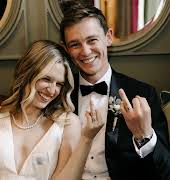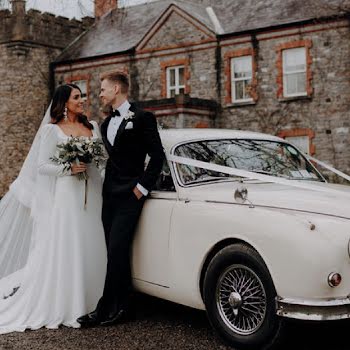The tweed ribbon detailing in designer Aoife McNamara’s That Feeling dress puts a fresh, fun spin on the traditional material, €375 at aoifemcnamara.com
Irish tweed: how the next generation of Irish designers are reinterpreting the heritage textile
Irish tweed has a fascinating history, one that continues to evolve as each generation reinterprets it with their own vision.
The beautiful thing about the Irish countryside in spring is how colour emerges from the landscape, lighting up the patchwork of stone walls and green fields. Yellow irises dot the grass, hawthorn blossom appears like white lace along the hedgerows, and a haze of purple heather becomes visible on the hills.
It’s a scene which has found itself woven into our very wardrobes with designers of tweed citing the ever-changing colours of the Irish landscape as being the inspiration behind patterns, colourways and finishes.
How lucky are we to have such a heritage of textiles in Ireland, which we can trace back to not only the lush green hills of our land (by way of the sheep that create the wool for the yarn) but to our own unique history?
Vawn Corrigan, author of Irish Tweed: History, Tradition, Fashion (O’Brien Press, €12.99) gives insight into the evolution of the cloth: “Despite the similarities between the weaving traditions, Irish tweed is not of Scottish origin [like Harris Tweed, for example]. It has had its own distinct and ancient path.”
We can date weaving in Ireland back to Neolithic times, and it’s from these very early beginnings the act of weaving began in Ireland. Corrigan says, “Hand- weaving maintained a central role in the story of Irish textiles. In Europe, weaving had moved out of the home by the 1800s; whereas in Ireland, the domestic tradition was developed into a strong home industry for regions with poor land and high unemployment. It continued to be supported right up to the 1960s, with the majority of them located in Donegal, the region where tweed was brought to its zenith in the 19th century and where the skill has passed, unbroken from generation to generation.”
We hope Donegal tweed will obtain EU geographical status, which already exists for agricultural products like champagne in France… It would be a formal stamp of approval.
This is exactly what makes tweed so special; captured in its make is the very essence of Irish ingenuity. This “unbroken line of knowledge” was (and continues to be) hugely valuable and lucrative. The vogue for tweeds began in the 19th century when Queen Victoria and Prince Albert made estate tweeds popular. In the 1920s, Chanel interpreted this English country look into her iconic tweed jackets and in the 1930s, the Duke of Windsor popularised the Prince of Wales check.
On Irish soil, tweed has been fashionable as a way of expressing national identity. In the early 20th century, Gaelic Revivalists and rebels alike used it to promote Irishness, with Countess Markievicz fashioning a soldierly outfit of dark green tweed for her rebel activities. In the 1950s, Sybil Connolly designed the fabric into haute couture looks for high-society American heiresses. She worked with both Magee 1866 and Mourne Textiles; a key moment being when her striking red Kinsale tweed cloak, modelled by Anne Gunning, was featured on the cover of Life magazine in 1953 with the headline “Irish invade fashion world”.
Today, with so many Irish designers, weavers and makers dedicated to the cloth, a whole new wave of styles have arrived. Take designer Cleo Prickett, based in Durhamstown Castle in Co Meath, whose key tweed supplier is Magee 1866. She gives a background on its relevance right now: “The fashion industry is going full circle at the moment. Synthetic fabrics were heavily used because they were seen as a more modern, efficient way of producing cloth. Now, with the climate crisis, we know these are not eco-friendly to produce; they don’t last well and they don’t biodegrade.” Cleo’s Yaddi tweed jacket is a case in point and workable for both summer and winter.
How lucky are we to have such a heritage of textiles in Ireland, which we can trace back to not only the lush green hills of our land (by way of the sheep that create the wool for the yarn) but to our own unique history?
Meanwhile, in a charming thatched cottage in Adare, Co Limerick, Aoife McNamara, an alumni of Limerick School of Art & Design, is fostering a culture of collaboration by partnering with local mills like John Hanly for her collections. A standout piece is her That Feeling pink dress finished with woven tweed ribbons and bows. Over in Galway, The Tweed Project subverts the traditional notion of tweed, offering sweaters and joggers and the iconic tweed blanket coat, a very new type of Galway shawl. “It’s a fabric that’s intrinsically Irish, it’s of us,” the duo enthuse. “Tweed feels very grounded.”
Designers, journalists and historians all agree Irish tweed needs to be valued. The folks at Magee 1866 are hopeful: “We hope Donegal tweed will obtain EU geographical status, which already exists for agricultural products like champagne in France. It would be a formal stamp of approval for Donegal tweed and would give clarity to consumers worldwide that they are purchasing the genuine article.”
We have such an interesting textile past in Ireland that, against all the odds, continues to inspire and delight well beyond our borders. A recognition of Irish design by the EU would be just the ticket to spin the magic of tweed well into the 21st century.

In the early 20th century, tweed was worn in Ireland as a way of expressing national identity, from Celtic Revivalists to female Irish volunteers who wore hand-woven green tweed uniforms to signify their political allegiances.
By the 1950s, the romance and craft of Irish fashion was captured by designer Sybil Connolly, placing Irish tweed on the world stage.
Princess Grace makes a state visit to Ireland in June of 1961 where she was gifted hand- woven green tweed from Millars Connemara, which she later had fashioned into an immaculately tailored suit by Balenciaga.
In the 1970s, Garech Browne, founder of Claddagh Records, developed his take on an Irish folk look, styling hand-knitted Aran jumpers and tweed trousers with crios belts. A love-affair with tweed he continued to enjoy for the rest of his life.
In 2023, we see tweed in the Oscar-nominated film, The Banshees of Inisherin. Costume designer Eimer Ní Mhaoldomhnaigh weaves Donegal tweed into the dark brown, cowboy-style overcoat as seen on Brendan Gleeson.
This article originally appeared in the Spring issue of IMAGE Magazine. Have you thought about becoming an IMAGE subscriber? Our Print & Digital subscribers receive all four issues of IMAGE Magazine and two issues of IMAGE Interiors directly to their door along with access to all premium content on IMAGE.ie and a gorgeous welcome gift worth over €65 from Brooke & Shoals. Visit here to find out more about our IMAGE subscription packages.



















